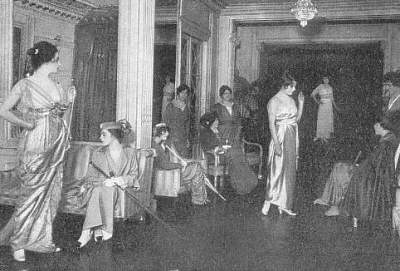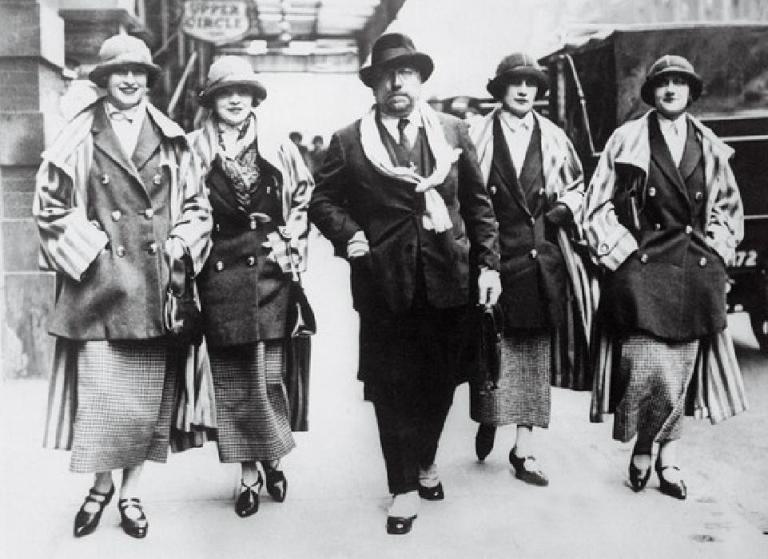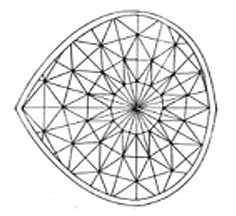Sofia Busignani
Il contributo più significativo al primo sviluppo della sfilata venne da una sarta londinese: Lady Duff Gordon, conosciuta come Lucile. Intorno al 1900 mise in scena le sue prime sfilate a Londra, nel suo negozio di Hanover Square. Negli anni Dieci portò le sue mannequins sulla scena internazionale, usando il loro prestigio e glamour per affermarsi oltreoceano, e divenne la prima couturier internazionale ad avere filiali in quattro città contemporaneamente (Londra, New York, Parigi e Chicago). Anche se più tardi affermò di aver inventato lei la sfilata, come si sarebbe intesa negli anni Trenta e Quaranta, in realtà le sue forme di presentazione erano più delle “mannequins parade”, un incrocio tra una festa d’élite e un evento teatrale, che si tenevano nel suo lussuoso salone o, in estate, nel suo giardino. La sua seconda innovazione principale fu la scelta, lo styling e l’addestramento delle sue mannequins, che i giornalisti di moda notavano bene, rispetto al modo di presentare gli abiti delle ragazze di altre maisons. Affermava di essere stata la prima a far togliere il fourreau nero alle mannequins, non riconoscendo che anche altri sarti parigini e londinesi avevano usato fourreaux color carne già nel 1897 e molti lo stavano abbandonando del tutto nel 1907. Fu probabilmente la prima a costruire un palco nel suo salone (del palco parigino di Beer se ne ha testimoninza per la prima volta nel 1903). Le sfilate spesso duravano un’ora e mezza o più e i clienti aspettavano mentre i capelli delle mannequins venissero sistemati per adattarsi allo stile di ogni abito, con pantofole e calze cambiate per abbellirli correttamente.

Mentre Lucile sviluppava le sue sfilate a Londra, Paul Poiret apriva la sua prima maison de couture a Parigi nel 1903, al numero 5 di rue Auber. Da qui Poiret iniziò a dare il proprio, considerevole, contributo alla storia delle sfilate come moderna forma di marketing e promozione della moda. Come Lucile, Poiret era noto per le sue presentazioni seducenti e per il modo in cui accessoriava accuratamente le mannequins e anche lui usava il suo giardino per alcune sfilate, di cui se ne parlava anche oltreoceano. A differenza di Lucile e Beer però, Poiret non costruì un palco per le sfilate fino al 1909, quando si trasferì in un antica villa settecentesca, dove installò un piccolo proscenio. La presentazione dei suoi capi veniva svolta davanti a circa ottanta persone al giorno, dalle cinque alle sette di ogni pomeriggio. Aveva chiaramente un senso delle esigenze del commercio internazionale e mantenne forti legami con i grandi magazzini europei e americani, viaggiando a Berlino nel 1910, visitando l’Europa nel 1911, l’America nel 1913, e ancora entrambi i continenti negli anni Venti. Si preoccupò di escludere i copisti non autorizzati dai suoi spettacoli e affrontò la pirateria seguendo un sistema “che, come tutti gli assicuravano, lo avrebbe rovinato”. La sfilata fu solo uno dei dispositivi che Poiret mise in atto per promuovere il suo business, secondo la formula di quello che oggi si chiamerebbe lifestyle marketing. Negli anni che precedettero la prima guerra mondiale, oltre a gestire la sua casa di moda e a mettere in scena le sfilate, produsse un profumo, disegnò per il teatro, aprì uno studio e una scuola di design d’interni, coltivò la stampa e organizzò spettacolari feste a tema. Fece tour di mannequins oltreoceano e commissionò a illustratori, come Iribe e Lepape, album di lusso dei suoi disegni.


Non si parla della magnanimita’ e della grande generosita’ di Poiret, che lo condussero a finire in miseria.
Vero, ma essendo il focus di questa rubrica la sfilata e le sue modalità, più che i suoi protagonisti, si è scelto di non entrare troppo nei dettagli delle biografie.